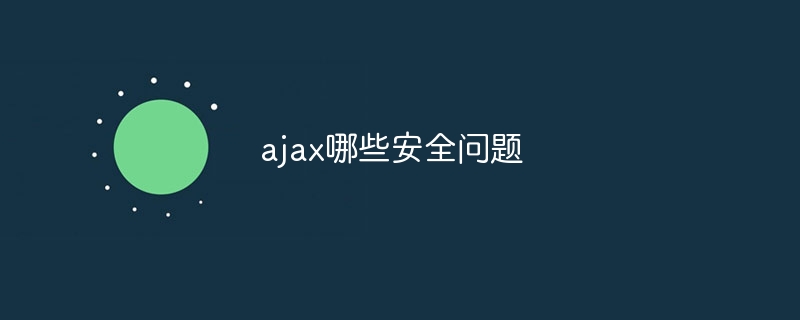
Ajax security issues include cross-site scripting attacks, cross-site request forgery, data leakage, insecure communication, improper error handling, insufficient support for mobile devices, insufficient support for older browsers, etc. Detailed introduction: 1. Cross-site scripting attack is a common web security threat. Attackers inject malicious scripts into web applications to obtain users' sensitive information or perform other malicious operations; 2. Cross-site request forgery is An attack method in which attackers forge legitimate user requests, exploit vulnerabilities in web applications, etc.

The operating system for this tutorial: Windows 10 system, DELL G3 computer.
AJAX (Asynchronous JavaScript and XML) is a technology that exchanges data with the server through asynchronous requests without reloading the entire page. While AJAX provides many advantages, such as improved user experience and performance, it also introduces some security concerns. The following are some common AJAX security issues:
1. Cross-site scripting attack (XSS): Cross-site scripting attack is a common web security threat. Attackers inject malicious scripts into web applications. Obtain users' sensitive information or perform other malicious operations. In AJAX applications, if the server does not properly sanitize or validate user input, a malicious user could exploit an AJAX request to inject malicious script into the server response to steal user data or perform other attacks.
2. Cross-site request forgery (CSRF): Cross-site request forgery is an attack method in which attackers forge requests from legitimate users and exploit vulnerabilities in web applications to perform malicious operations. In an AJAX application, if the server does not properly validate information such as the user's identity or session token, an attacker may be able to perform malicious actions by using AJAX requests to forge requests from legitimate users.
3. Data leakage: AJAX allows data exchange with the server in the background, which may lead to the leakage of sensitive data. If the server does not properly protect sensitive data, or if the AJAX application does not handle sensitive data correctly, an attacker can steal the data and use it for malicious purposes.
4. Insecure communication: AJAX uses HTTP protocol for data exchange by default. However, if the AJAX application does not use HTTPS or other security protocols to protect the communication channel, attackers may steal or tamper with data through means such as Man-in-the-Middle Attack.
5. Improper error handling: In AJAX applications, if errors are handled improperly, it may lead to security issues. For example, if an AJAX request fails without proper error handling or validation, an attacker could exploit these vulnerabilities to perform malicious actions.
6. Insufficient support for mobile devices: Although AJAX is widely supported in desktop browsers, there may be some problems on mobile devices. Some older mobile devices may not fully support AJAX functionality, or support may vary. This can lead to security issues, as different devices may employ different security mechanisms and vulnerability fixes.
7. Insufficient support for older browsers: Some older browsers may not fully support AJAX technology, which may cause compatibility issues. If AJAX applications do not take into account the limitations and vulnerabilities of these older browsers, security issues may be introduced.
In order to solve these security problems, the following measures can be taken:
1. Input verification and filtering: Ensure that the server verifies and filters all user input to prevent malicious users from injecting malicious scripts or data .
2. Authentication and session management: Implement strict authentication and session management mechanisms on the server side to ensure that AJAX requests come from legitimate users and sessions.
3. Use HTTPS: Use HTTPS or other security protocols to protect the AJAX communication channel and prevent man-in-the-middle attacks from stealing or tampering with data.
4. Error handling and exception handling: Implement appropriate error handling and exception handling mechanisms in AJAX applications so that appropriate handling and verification can be performed when errors occur.
5. Updates and Maintenance: Regularly update and maintain AJAX applications and related technology stacks to ensure they are up to date with the latest security standards and vulnerability fixes.
6. Education and training: Provide security awareness and skills training to developers and administrators so that they understand common web security threats and protective measures.
7. Use secure libraries and frameworks: Choose JavaScript libraries and frameworks that are securely designed and implemented to build AJAX applications. These libraries and frameworks usually provide built-in security features and protections.
8. Data encryption: For sensitive data, encryption algorithms can be used to encrypt the data for storage and transmission to ensure that even if the data is stolen, it cannot be used directly.
9. Use the latest version: Make sure to use the latest version of the AJAX framework and library. These versions usually fix known security vulnerabilities and add new security features.
10. Regular security audits: Regularly conduct security audits of AJAX applications to discover and fix potential security issues. This can be done through a professional security audit team or security consulting services.
To sum up, although AJAX brings some advantages, it also has some security issues. To secure AJAX applications, comprehensive security measures are required to address these threats.
The above is the detailed content of What are the security issues with ajax?. For more information, please follow other related articles on the PHP Chinese website!




